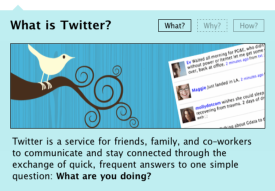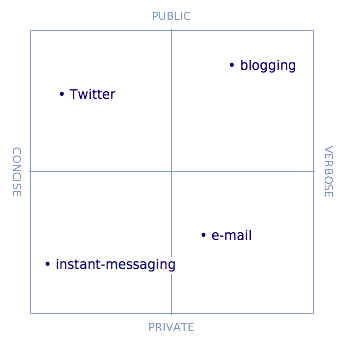How to explain Twitter

After ignoring Twitter at first, my curiosity about a new communication channel led me to start using it this year. The easy thing about Twitter is working out how to use it. The hard thing about Twitter is to explain to other people what is going on and why. This article has a few suggestions.
A long-term technology trend, characteristically accelerated by the Internet, is the introduction of new ways to communicate that supplement existing channels rather than replacing them. Although many ultimately disappear, many have made it through the whole Ghandi-cycle (obscurity, ridicule, conflict, then success). Along the way, many technologies have provoked the most bizarre discussions about their raison d’être, as if any technology were ever self-justifying.
When you start using a technology that is still being ignored, people do not respond when you tell them that you are using it. Twitter is now in the ridicule phase, which I noticed as soon as I started telling people that I had opened a Twitter account: reactions are frequently both strong and dismissive.
The ostensible reason
Twitter is a way to quickly and frequently communicate what you are doing, according to Twitter’s own web site.

You even get a cute avian metaphor; Twitter posts are called 'tweets'.
Writing a public incremental daily diary is clearly behaviour that would require some justification, so Twitter has a help page that explains why you might do this. You may or may not buy this. You may or may not be prepared to admit to friends and colleagues that you think this is reasonable behaviour.
The analytical explanation
The analytical approach to explaining Twitter considers how it relates to established Internet-based communication channels.

Twitter is like IM but public, and like blogging but less verbose. This is mostly saying what Twitter is not, of course, but at least it suggests a short answer.
The short answer
Twitter is blogging, but with very short posts. Micro-blogging, if you like. A Twitter post has to be at least as concise as this paragraph.
When I compare Twitter to blogging, I sometimes see in people’s eyes that they think that blogging is 'stupid' as well. Meanwhile, in the face of its clear mainstream success, they have either given up fighting it or are just keeping quiet because they know that they have lost.
There is a clear emotional and ideological gulf between people who write by choice or even for pleasure, and those for whom writing will only ever be 'work'. I blame schools. No wonder people who love or hate writing wind each other up, a situation hardly helped by contributions like Steve Yegge’s judgement that You Should Write Blogs, and other such evangelism.
The constructivist hypothesis
Twitter is not for anything, it is up to you how you use it. Perhaps Twitter needs no more explanation or justification than web pages or printers do. These are all ways to publish information that each turn out to be useful in more than one way.
However, this hypothesis leads us to expect that Twitter will be copied or independently re-invented as the same thing with a different explanation as use. As far as I know, that has not happened yet.
The personal view
Fortunately, Twitter is all about me, in common with the way that I experience other social networking software, so I get to decide how to use Twitter. Your mileage may vary.
-
Post about what you do, what you learn and new ideas you have.
-
Conversations belong in instant messaging at chat rooms, not on Twitter.
-
Write for your audience; ignore 'followers' you have never met.
-
Only follow people you know, because 140 characters leaves no room for the context you need to understand someone’s perspective.
Use Twitter to explain yourself, every day.
